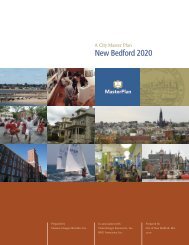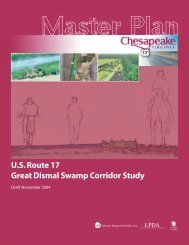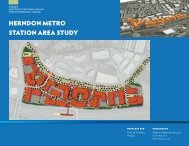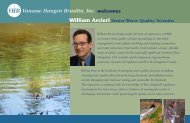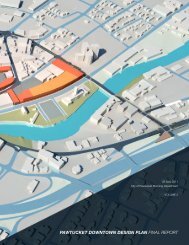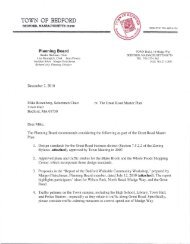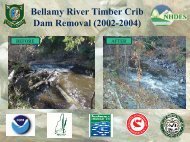Final Report - VHB.com
Final Report - VHB.com
Final Report - VHB.com
You also want an ePaper? Increase the reach of your titles
YUMPU automatically turns print PDFs into web optimized ePapers that Google loves.
1/Gurnet Road is projected to improve from LOS F to LOS C and the intersection of<br />
Gurnet Road and Forrestal Drive/Lee’s Tire is projected to improve from LOS C to<br />
LOS B.<br />
In general, each of the three options either moderately or substantially meets the five<br />
study objectives. As for the objectives of “improving mobility” and “ac<strong>com</strong>modating<br />
NASB travel demands,” Option 3 is rated as moderately meeting the objectives as<br />
<strong>com</strong>pared to Options 1 and 2, which are rated as substantially meeting them. Options<br />
1 and 2 provide direct free-flow ramps as <strong>com</strong>pared to Option 3, which includes a<br />
series of traffic-signal–controlled intersections.<br />
Environmental Impacts<br />
The locations of the proposed interchanges providing direct access from US Route 1<br />
into the NASB for Options 1 and 2 occupy the same general area. Therefore, these<br />
two options affect similar environmental resources but differ slightly due to different<br />
footprints associated with each. However, Option 3 is located closer to Cooks Corner<br />
(i.e., to the east relative to Options 1 or 2); therefore, it affects a different set of<br />
environmental resources, which are discussed in the following subsections.<br />
Environmental Resources<br />
Option 1 and 2 would both impact a large scrub-shrub/forested wetlands, located<br />
just west of the Merrymeeting Plaza on State Route 24 (i.e., Bath Road). Additionally,<br />
the “trumpet/loop” portion of Option 1 would be located on the north side of<br />
US Route 1, impacting a second emergent wetlands system. Potential impacts to<br />
wetlands for Strategy 1 range from 1.2 acres (Option 3) to 4.0 acres (Option 1).<br />
Stream-crossing impacts range from one stream crossing associated with Option 1 to<br />
three stream crossings associated with Option 3.<br />
The primary measure for water quality used in this Feasibility Study is the number of<br />
new impervious surfaces associated with the construction of each option (i.e.,<br />
measured as the number of acres of new pavement). Option 1 has the largest project<br />
footprint of the three options evaluated and therefore would have a slightly larger<br />
impact on water quality than Option 2 or 3. However, potential water-quality<br />
impacts can be managed through the use of appropriate water quality best<br />
management practices (BMPs) including stormwater detention and treatment<br />
structures. Such measures would be designed if any of the options is selected for<br />
advancement to preliminary design.<br />
All options for Strategy 1 would impact the floodplains with Option 1 having the<br />
greater impact on these resources than Options 2 and 3. The “trumpet/loop”<br />
footprint of Option 1 would be located primarily within the Zone AE floodplain<br />
associated with the Androscoggin River. This is one of the more notable impacts<br />
associated with any of the proposed options and would require discussion with<br />
resource agencies such as the Maine DEP and the U.S. Army Corps of Engineers<br />
Conclusions 148



